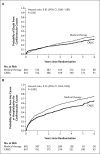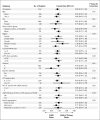Coronary-artery bypass surgery in patients with left ventricular dysfunction
- PMID: 21463150
- PMCID: PMC3415273
- DOI: 10.1056/NEJMoa1100356
Coronary-artery bypass surgery in patients with left ventricular dysfunction
Abstract
Background: The role of coronary-artery bypass grafting (CABG) in the treatment of patients with coronary artery disease and heart failure has not been clearly established.
Methods: Between July 2002 and May 2007, a total of 1212 patients with an ejection fraction of 35% or less and coronary artery disease amenable to CABG were randomly assigned to medical therapy alone (602 patients) or medical therapy plus CABG (610 patients). The primary outcome was the rate of death from any cause. Major secondary outcomes included the rates of death from cardiovascular causes and of death from any cause or hospitalization for cardiovascular causes.
Results: The primary outcome occurred in 244 patients (41%) in the medical-therapy group and 218 (36%) in the CABG group (hazard ratio with CABG, 0.86; 95% confidence interval [CI], 0.72 to 1.04; P=0.12). A total of 201 patients (33%) in the medical-therapy group and 168 (28%) in the CABG group died from an adjudicated cardiovascular cause (hazard ratio with CABG, 0.81; 95% CI, 0.66 to 1.00; P=0.05). Death from any cause or hospitalization for cardiovascular causes occurred in 411 patients (68%) in the medical-therapy group and 351 (58%) in the CABG group (hazard ratio with CABG, 0.74; 95% CI, 0.64 to 0.85; P<0.001). By the end of the follow-up period (median, 56 months), 100 patients in the medical-therapy group (17%) underwent CABG, and 555 patients in the CABG group (91%) underwent CABG.
Conclusions: In this randomized trial, there was no significant difference between medical therapy alone and medical therapy plus CABG with respect to the primary end point of death from any cause. Patients assigned to CABG, as compared with those assigned to medical therapy alone, had lower rates of death from cardiovascular causes and of death from any cause or hospitalization for cardiovascular causes. (Funded by the National Heart, Lung, and Blood Institute and Abbott Laboratories; STICH ClinicalTrials.gov number, NCT00023595.).
Figures



Comment in
-
Underestimating medical therapy for coronary disease... again.N Engl J Med. 2011 Apr 28;364(17):1671-3. doi: 10.1056/NEJMe1103414. Epub 2011 Apr 4. N Engl J Med. 2011. PMID: 21463151 No abstract available.
-
CABG in patients with left ventricular dysfunction.N Engl J Med. 2011 Aug 4;365(5):470; author reply 470-1. doi: 10.1056/NEJMc1106549. N Engl J Med. 2011. PMID: 21812685 No abstract available.
-
CABG in patients with left ventricular dysfunction.N Engl J Med. 2011 Aug 4;365(5):469-70; author reply 470-1. doi: 10.1056/NEJMc1106549. N Engl J Med. 2011. PMID: 21812686 No abstract available.
-
CABG in patients with left ventricular dysfunction.N Engl J Med. 2011 Aug 4;365(5):469; author reply 470-1. doi: 10.1056/NEJMc1106549. N Engl J Med. 2011. PMID: 21812687 No abstract available.
-
CABG in patients with left ventricular dysfunction.N Engl J Med. 2011 Aug 4;365(5):468-9; author reply 470-1. doi: 10.1056/NEJMc1106549. N Engl J Med. 2011. PMID: 21812688 No abstract available.
-
CABG in patients with left ventricular dysfunction.N Engl J Med. 2011 Aug 4;365(5):468; author reply 470-1. doi: 10.1056/NEJMc1106549. N Engl J Med. 2011. PMID: 21812689 No abstract available.
-
ACP Journal Club. CABG added no benefit to medical therapy for preventing death in CAD with heart failure.Ann Intern Med. 2011 Aug 16;155(4):JC2-9. doi: 10.7326/0003-4819-155-4-201108160-02009. Ann Intern Med. 2011. PMID: 21844542 No abstract available.
-
Pomostowanie aortalno-wieńcowe u pacjentów z dysfunkcją lewej komory: analiza badania STICH.Kardiol Pol. 2011;69(9):979-80. Kardiol Pol. 2011. PMID: 21928219 Polish. No abstract available.
-
In patients with coronary artery disease and heart failure, the addition of coronary-artery bypass grafting to medical therapy has no effect on the overall risk of death from any cause, but assessment of suitability for surgery may predict survival benefit in subgroups.Evid Based Med. 2012 Dec;17(6):178-9. doi: 10.1136/ebmed-2012-100641. Epub 2012 Jun 26. Evid Based Med. 2012. PMID: 22736663 No abstract available.
References
-
- Lloyd-Jones D, Adams RJ, Brown TM, et al. Heart disease and stroke statistics — 2010 update: a report from the American Heart Association. Circulation. 2010;121(7):e46–e215. - PubMed
-
- Dickstein K, Cohen-Solal A, Filippatos G, et al. ESC guidelines for the diagnosis and treatment of acute and chronic heart failure 2008: the Task Force for the Diagnosis and Treatment of Acute and Chronic Heart Failure 2008 of the European Society of Cardiology: developed in collaboration with the Heart Failure Association of the ESC (HFA) and endorsed by the European Society of Intensive Care Medicine (ESICM) Eur Heart J. 2008;29:2388–442. - PubMed
-
- Gheorghiade M, Sopko G, De Luca L, et al. Navigating the crossroads of coronary artery disease and heart failure. Circulation. 2006;114:1202–13. - PubMed
-
- Coronary Artery Surgery Study (CASS): a randomized trial of coronary artery bypass surgery: survival data. Circulation. 1983;68:939–50. - PubMed
-
- The Veterans Administration Coronary Artery Bypass Surgery Cooperative Study Group Eleven-year survival in the Veterans Administration randomized trial of coronary bypass surgery for stable angina. N Engl J Med. 1984;311:1333–9. - PubMed
Publication types
MeSH terms
Associated data
Grants and funding
LinkOut - more resources
Full Text Sources
Other Literature Sources
Medical
Molecular Biology Databases
